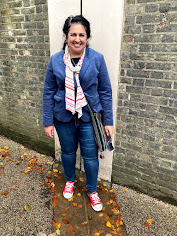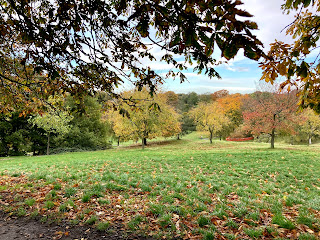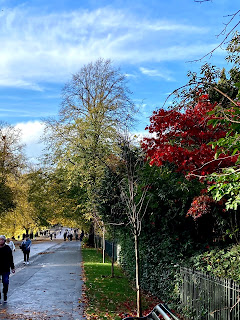So we're not actually in a lockdown, but as close as you can get without calling it a lockdown. Grocery stores are open, public transportation is still running (such as the Thames Clipper, a ferry service that didn't run during the last lockdown-type month in November), take-out is still an option, and places of worship are open with limitations on the numbers of attendees. But pretty much everything else is shut down again. Christmas Day, you can't meet with anyone outside your own household now, and even outside, where it was the "rule of 6," that has been limited to just meeting a single person outside. I see that food stalls are still open, such as cafes in parks where there aren't chairs for sitting, so people can't congregate there, so we'll probably end up doing that a lot, going for walks or bike rides in parks and then stopping for a coffee outdoors. It's all due to a new strain of the virus that appears to so far be contained in the UK but that is more contagious and spreads faster than the other strains we already have had spreading. So London and parts of Southeast England have gone into a new category of restrictions called tier 4. We're not sure how long it will last, but as before, the virus is unpredictable, which means that for now, it dictates our next steps unpredictably.
Meanwhile, I thought I'd share some more about life here. Before I get into that, I should say that I'm happy to provide this little window into life abroad for friends and family at home. I've come to realise that I'm able to help people see the world, even if through just my perspective, but perhaps in a way that allows people to travel through my stories and photos and perhaps forget about the Covid for a while.
Behind the Scenes
The other day, my husband took some clothing items in to get some alterations done. When we went to pick up the order, we were ushered into the back room where they do the actual sewing and pressing because someone was already being helped in the main part of the store, and it's quite small, so there wasn't a way to social distance there. It was just kind of neat seeing the way it all works, this quaint little place with a man in suspenders doing the sale and an Eastern European woman sewing up a storm in the back--she does excellent work, and we were very happy with the quality of the alterations! I figured my mom would love a sewing room like this, sans the computer and files for the business part of the back room.
Shop Front Fun
On the local side, I saw what looked to be a drycleaner store. I was standing in line at the post office, which appears to be operated by some Bangladeshi immigrants, and many of the shops surrounding it are either Bangladeshi-owned or at least South Asian. As you can see in the photo, the drycleaning definitely caters to a South Asian population since you can see some very fancy traditional clothing through the window. What surprised me was looking up at what the store purported to offer: IT services! It was hilarious! I'm sure they actually do offer those services, but nowhere does it indicate that they are also a drycleaner, yet you can clearly see in the window that they do offer this service. It just made me laugh because it's so like Indian and Pakistani places that you can find that tend to specialise in everything. Like I've seen in Pakistan a restaurant that specialises in Chinese, Pakistani, Italian, and Lebanese cuisine. At home, there was a Punjabi-owned autobody shop whose slogan read: "Specialising in foreign and domestic vehicles." Are there any other kinds of cars once you've covered the globe? Is that really a specialty when you cover all that territory? It's become a constant source of entertainment for our family--and I have to say that my dad actually did ream out the guy at the autobody shop, in a way that only one Punjabi can to another, to let him know that his slogan made no sense. Surprisingly, the guy did eventually change it! In any case, I love this kind of stuff.
 |
| Up close, the pattern of the robe has tiny skulls and crossbones |
At the other end of the spectrum are the posh stores you find on Jermyn Street. This is a haven for the true gentleman, and quite possibly the up-and-coming rapper who can afford to look posh but still wants to stick to his "streetwear" look, as evidenced by a mannequin I saw with a lovely tweed coat worn over a half-zip sweater and fleece jogging pants. Or it might even be a wealthy socialite who wants to dress posh and gentlemanly but thinks that putting a skull and crossbones pattern on his bespoke dressing gown (British term for custom-made robe/housecoat) will make him look edgy. I find the whole notion of these stores offering bespoke loungewear kind of funny, and I wonder if anyone really still wears these. Perhaps they are indeed decreasing in popularity, as we noticed that many stores in this area have closed down permanently due to the pandemic, which perhaps only catalysed their demise. Without the same number of men going to the office, the need for such haute couture business wear (it's not just loungewear, but suits and all the accoutrements at some of the same shops) are on their way out. There are stores that specialise(d) in cuff links, cobbler-made shoes, and grooming products, not just suits and loungewear. Perhaps it's not totally surprising that there is no need to have stores having such focused specialties, as much as perhaps one shouldn't try to specialise in everything.
you will see the smoking cap, a Middle- or Near East-style cap with a tassel on it. I was interested in the origins of the hat, and it turns out that the smoking cap began to be used in the Victorian era and was intended to protect the man's hair from absorbing the smell of tobacco. Women would stitch the hats themselves and give as a gift to their husband, the idea being that, especially when worn with a smoking jacket, a man could go off and smoke and return to his lady without the smell of smoke upon him to upset her, according to the social norms of the day. In the one photo, you'll see a set of pyjamas and a robe with Chinese patterns. Both the smoking cap and the robe/PJ combo are remnants of the Victorian society's fascination with other cultures. They would bring designs and patterns into their own society in almost exaggerated ways, in what has been called "orientalist" and "chinoiserie." You'll notice this a lot in art from the era, wallpapers with rich Chinese patterns behind the subject of a portrait or silk and brocade articles of clothing on the person with these ornate patterns. The reason that it is colonial, however, is that this fascination wasn't because the Victorians valued the subject of their fascination but that they exoticised these cultures, viewed them almost as someone would find a freak show fascinating. It was different and new and exotic, and people wanted to partake in it, not learn more about the cultures that created them and feel that they were equals to be cared about or respected. Anyway, that's getting into some sociological analysis, but I do take interest in thinking about and examining even what these clothing styles mean.
Meanwhile, the streets are decorated beautifully for Christmas, which is a perfect segue into my next topic!

















































